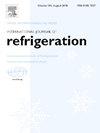Techno-economic analysis of chemical looping heat pumps based on the levelized cost of energy
IF 3.5
2区 工程技术
Q1 ENGINEERING, MECHANICAL
International Journal of Refrigeration-revue Internationale Du Froid
Pub Date : 2025-02-01
DOI:10.1016/j.ijrefrig.2024.11.032
引用次数: 0
Abstract
The chemical looping heat pump (CLHP) is a promising electrochemical heat pump technology due to high system efficiency, scalability, and use of low-to-zero Global Warming Potential (GWP) fluids. However, similar to other emerging HVAC&R technologies, there is a lack of direct comparison and discussion of economics between CLHPs and conventional vapor compression (VC) heat pumps. In this work, a generalized modeling framework to estimate the levelized cost of energy (LCOE) for space conditioning applications is used to assess the early-stage economic feasibility of CLHP. The LCOE consists of two components: levelized operating expenditures and levelized capital expenditures. These clarify the influence of key factors such as annual cooling and heating delivered and price of electricity. The simulations show that the LCOE of CLHP could be less than that of VC in the case of unit utilization of 30,000 kWh yr−1, operating current density of 0.4 A cm−2, and 30% performance improvements. This is despite the projected capital cost of CLHP is nearly 1.6 times higher than that of VC system.
求助全文
约1分钟内获得全文
求助全文
来源期刊
CiteScore
7.30
自引率
12.80%
发文量
363
审稿时长
3.7 months
期刊介绍:
The International Journal of Refrigeration is published for the International Institute of Refrigeration (IIR) by Elsevier. It is essential reading for all those wishing to keep abreast of research and industrial news in refrigeration, air conditioning and associated fields. This is particularly important in these times of rapid introduction of alternative refrigerants and the emergence of new technology. The journal has published special issues on alternative refrigerants and novel topics in the field of boiling, condensation, heat pumps, food refrigeration, carbon dioxide, ammonia, hydrocarbons, magnetic refrigeration at room temperature, sorptive cooling, phase change materials and slurries, ejector technology, compressors, and solar cooling.
As well as original research papers the International Journal of Refrigeration also includes review articles, papers presented at IIR conferences, short reports and letters describing preliminary results and experimental details, and letters to the Editor on recent areas of discussion and controversy. Other features include forthcoming events, conference reports and book reviews.
Papers are published in either English or French with the IIR news section in both languages.

 求助内容:
求助内容: 应助结果提醒方式:
应助结果提醒方式:


